The Old Mill and Mill Cottages Harrold
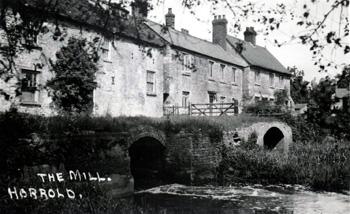
Harrold Mill about 1920 [ref: Z1306/54]
Middle Ages
A mill valued at 36 shillings and 8 pence was recorded at Harrold in the Domesday Book of 1086. Where it lay was unknown, but it would have been a watermill, as windmills were not introduced into England until over a hundred years later.
Volume XLI of Bedfordshire Historical Records Society contains coroner's rolls for medieval Bedfordshire translated by R.F.Hunnisett. Entry 241 reads: "About nones [3 p.m.] on 17 May [1276] Robert son of Margery and John son of Richard of Harrold were riding on Ralph Morin's horses in Harrold and came to some water intending to water the horses. Robert entered the water first and stationed himself in a deep pool on the south of Harrold mill, fell over the horse's head into the pool and drowned by misadventure…" After this the record is silent for nearly three hundred years but a partial history of the mill from the 16th century to the 20th can be pieced together from sources held at Bedfordshire & Luton Archives & Records Service.
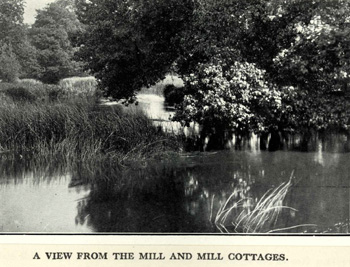
A view from the mill in 1925 [ref: Z1147/7]
16th Century
The next mention of the mill in Bedfordshire Archives is a brief bill for repairs to the mill in 1540 [ref: L26/588]. It was usual for the mill to be in the same ownership as the manor from the time of Domesday inwards and this was the case at Harrold until the 17th century. In 1584 Henry Grey, Earl of Kent (Lord of the Manor), leased the mill to John Orlyber of Harrold, miller, for ten years at a rent of £19 per annum. The mill is described as mills, because the standard practice was to count each pair of mill wheels as a separate mill. Thus the description is "two water mills under one roof…with all buildings. The stream of water on which the mill stands, the holmes, cobbs and beds of oziers, and rushes, and free fishery in the water of Ouse and Lord's mead ditch adjoining". The lease also included a cottage and two closes of pasture in occupation of Elizabeth Bawde, widow, one close was called Saffron Close, adjoining the river and which "lyeth near unto the tayle of the said mills". The other was called Sweetapples of Welwycks and lay near Saffron Close.
Orlyber was to repair the buildings, dams, floodgates and tail of the mills and the banks of the watercourses, the Earl allowing him sufficient damboote [presumably building material such as stone] for repairing the dams and banks, the damboote to be dug at Orlyber's expense, The Earl would assign a place within the Manor of Harrold to dig the damboote. Orlyber was also to leave two good pairs of mill stones at the end of the term and to maintain the willows and oziers, replacing any that died. The Earl could fish there once or twice a year [ref: L7/52].
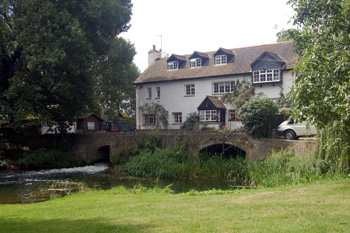
Harrold Mill July 2008
17th Century
Ten years later the Earl leased the mills to William Belfield of Harrold for nine years. The rent was now £60 per annum because the lease also included the Lodge in Harrold Park, a free fishery, John Orlebar's cottage (he still occupied the mill) and a close of land called Upper Conygree [ref: L7/53-54]. Presumably Orlebar now paid his rent to Belfield rather than the Earl. The lease was re-assigned to the Earl by William Belfield in 1601 [ref: L7/55].
In 1605 the Earl leased the mills to John Perry of Houghton Regis, miller, for eleven years at £25 per annum [ref: L7/59-60]. The mills, at that date, were described as being in occupation of John Watson (presumably he had taken over from John Orlebar and now Perry was replacing him). Oddly the miller's cottage was not included in the lease.
In 1617 John Perry was still at the mill. In that year Henry Grey, Lord Ruthin and trustees sold the mill, fishing rights, miller's cottage and six acres of pasture out of the manor to Sir Thomas Boteler [ref: L7/45-46]. In 1633 the Manor Court Rolls noted that the mill had been pulled down and re-erected by William Boteler in such as way as to cause flooding [ref: L26/563]. A conveyance of neighbouring ground in that same year noted that Thomas Justice was in occupation of the mill house [ref: TW585]. In a draft least of 1672 William Boteler proposed to let "two corn mills and one wheat mill with utensils, and a place formerly called Bowling Leys, and the fishing and rushing appertaining to the house, all lately in possession of William Saunders" to a man named Athey for a year at a rent of £20 per annum [ref: TW687].
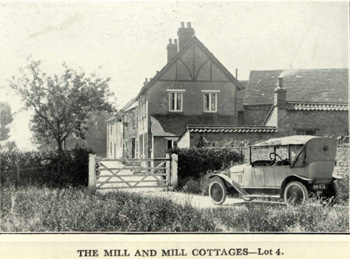
Mill Cottages in 1925 [ref: AD1147/7]
18th Century
William Boteler had no male heir and his daughter Elizabeth married William Farrar of Covent Garden. In 1712 Farrar conveyed the mills, miller's house and Bowling Close, previously in occupation of William Riseley to John Holt of Crawley [Northamptonshire], grazier for £250 [ref: WG1581]. In 1720 James Holt of Bromham, grazier conveyed Harrold Mills (described as two watermills and a corn mill) to John Mountague of Northampton, miller [ref: AD3880].
It seems that Mountague must have later sold the mill, though continuing as tenant, as in 1748 Rowland Alston conveyed the mills to Thomas Bletsoe of Harrold, miller. The transaction included not only the two watermills but also the former corn mill, which John Mountague had made into a dwelling for himself, and still lived in [ref: AD3381]. This view is further supported by an agreement of 1738 in which it was mentioned that the Duke of Kent was thinking of buying the mill, indicating that around that time Mountague was looking to sell [ref: L26/621].
In 1775 Ann Neale of Bletsoe, widow of Job Neale, assigned collateral security charged on Harrold Mills [ref: SJ1435a-b]. The assignment recites that in 1767 Job Neale had mortgaged Harrold Mills to provide payment of legacies, indicating that he must have bought them from Thomas Bletsoe, or his sucessor, at some date between 1748 and 1767. In 1780 William Neale, son of Job and Ann, together with his mother, conveyed Harrold "water corn mills" as well as a pasture between the mill dam and back stream to William Wootton of Harrold, lace merchant, for £350 [ref: SJ1437]. William Wootton died in 1807 [ref: SJ1448].
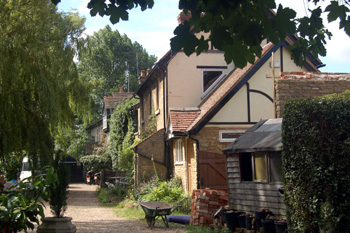
The old mill cottages at Harrold June 2008
19th Century
A letter from Joseph Pawsey to Countess de Grey on 24th January 1805 noted that the corn mill had burned down but that, fortunately, the fire had not spread to Manor Farm, owing to the great exertions of the tenants. The damage to the mill was estimated at £800 to £1,200 [ref: L30/11/215/155]. In 1824 the owner of the mill was William Benjamin Poole of Bedford, maltster and he leased the rebuilt Harrold mills to Samuel Bonfield for 31 years at a rent of £65 per annum [ref: GA1522].
Eve Gould (nee Poole) read this piece on-line and sent in the following additional information about the Poole family: "At the tender age of eleven years, William Benjamin Poole inherited land and property in Bedfordshire from his uncle, John Poole of Stevington, who died in the year 1801. His inheritance included: "All those my watercorn mill with the closes, holmes, hereditaments and appurtenances thereunto belonging, called Harrold Mills". As William Benjamin was only eleven years of age and an orphan, it must be supposed that the two executors of John's will, Benjamin Rogers of Carlton and Thomas Kidman of Bedford were also his guardians. Thomas Poole, the third of William Benjamin's sons, had taken over the mill by 1851 when his father moved to College Farm, Clapham. Thomas became quite well-to-do, as he had built some properties at Ashburnham Road, Bedford, which he named Harrold Villas. Thomas died childless in 1866 leaving his two houses at Harrold to his brother-in-law, Stephen Stevens of Harrold".
By using directories one can determine a partial list of millers between 1839 and 1914 as follows:
- 1839: Jesse Biggs;
- 1847: Benjamin William Poole;
- 1853-1862: Thomas Poole;
- 1864-1869: William Wykes;
- 1876-1885: Henry Keep;
- 1890-1894: Henry Charles Underhill;
- 1898-1903: William Alfred Richard Osborn;
- 1910-1914: Samuel Titmas
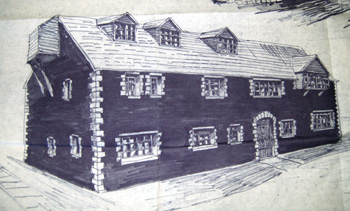
Impression of east elevation of the mill after alterations in 1976 [ref: BorB/TP/76/922]
20th Century
The mill seems to have ceased to operate as such about the beginning of the First World War. Certainly, in 1919 Harrold Mill was noted as not working [ref: WW1/AC/DR1]. In 1925 Priory Farm was sold at auction by P.& W.Anderson Limited, who were in liquidation. At this date the firm also owned the mill. The sale particulars [ref: AD1147/7] described the mill as: "The Valuable Water Mill including costly Electric Plant, together with the MILL RIGHTS and TWO COUNTRY COTTAGES Extensive views; good fishing and water fowl shooting.
"THE MILL brick and stone built with tiled roof is a three-storied Building, situate on the Ouse, and until recently used as a CORN MILL power being obtained from the LARGE WATER WHEEL, which is still in existence and in good repair, together with the inside Gear Wheel and Pulley Wheel. On the Second Floor are TWELVE CORN HOPPERS.
"THE MILL is now chiefly used for providing ELECTRICITY FOR THE ESTATE. The Plant consists of a TURBINE under the Mill, continually driven by the force of the water through a pair of Sluice Gates, the turbine driving a pair of 250 Volt Generators, with controlling Governors, and the plant is complete with Switchboards, etc., a direct current being provided for power and lighting on separate cables…The water level is governed by two Weirs, and one set of floodgates fitted with substantially built EEL TRAP.
"The water through the Mill is governed by two pairs of Sluice Gates, one pair for the water wheel and one pair for the Turbine. In the event of repairs being necessary to the Turbine the entrance Sluice Gates can be closed, and another pair of gates on the other side of the Mill can be also closed to prevent water trailing back.
"Detached near is a brick and tiled BLACKSMITH'S SHOP or GARAGE fitted with Garage Pit, forge and bench. In the Loft is a 7 h.p. Siemens Electric Motor with shafting and pulley wheel for driving lathe, grindstone, buffing machine etc. The Forge, bench, Motor, Shafting and Pulley Wheels only are included in the Sale.
"THE COUNTRY COTTAGES are brick and stone built, with tiled roof. The one next the Mill contains: - Hall, 3 Reception, Kitchen, pantry and 4 Bedrooms. THE COTTAGE adjoining contains Living Room, Kitchen, Pantry, Bath Room and W.C. 3 Bedrooms. Outside brick and tiled Scullery with copper; Barn; Iron roofed Wood Shed and Pump House fitted with semi-rotary pump for water supply.
"GOOD GARDENS. The last mentioned Cottage is in the service occupation of an Estate Workman, is in good repair and would readily let as a COUNTRY COTTAGE; the former Cottage is VACANT and with some expenditure on repairs and decorations would also readily let".
In 1927 property in Harrold was valued under the Rating & Valuation Act of 1925; every piece of land and building in the country had to be valued to determine the rates to be paid upon it. The valuer visiting The Mill House [DV1/C71/125-126] noted that the owner H.C.Lay [he presumably bought it at the auction of 1925] and the occupier Mrs.Lang [ a marignal note reads: "29/7/49 now occupied by Holkam ….. rent £100"]. The house stood in 0.413 acres and was constructed of stone, slate and tile. the valuer remarked: "was 2 houses".
The house comprised a hall, a kitchen measuring 12½ feet by 14 feet, a scullery, a bathroom and wc, a pantry, a lounge measuring 19½ feet by 10 feet and a bay measuring 12½ feet by 3 feet, a dining room measuring 13 feet by 18¾ feet, a drawing room measuring 16½ feet by 20 feet and a library measuring 12 feet by 13½ feet. Upstairs were a bathroom and wc, a lavatory [in the sense of a place to wash one's hands], a bedroom over the library measuring 12 feet by 13½ feet, a maid's room measuring 13½ feet by 9 feet, a bedroom over the drawing room measuring 16½ feet by 12 feet, a bedroom over the dining room measuring 10 feet by 18¾ feet, a bedroom over the kitchen, with a basin, measuring 13¾ feet by 14 feet and a bedroom over the lounge, with a basin, measuring 12½ feet square.
Outside was a brick and slate garage and store, a tool shed, a washhouse, a coalshed and woodshed. the valuer remarked: "Garden very small" and "Very nice house but bad shape - was 2 houses. Electric light from Mill. Very low lying position - joins mill & mill attendants have to pass in front of house".
He noted that the mill [ref: DV1/C71/127] was owned and occupied by Lay, Fairey & Rootham and stood in 1.294 acres. It was built of stone and tile and was "used for electric light supply". The valuer remarked: "Locked up. Couldn't see plant".

Sketch plan of mill after proposed alterations in 1976 [ref: BorB/TP76/922]
In 1976 the mill building was renovated and altered to form a home. Bedfordshire Archives has the plans [ref: BorB/TP76/922].